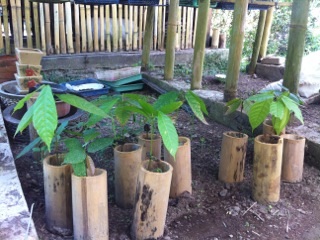Volunteers and research
/At Jiwa Damai, we love to explore and experiment and we are very open to new ideas. We encourage learning by doing in our permaculture garden.
Cedric was volunteering for a 6 month period. While completing his other volunteer responsibilities, he had an opportunity to research cacao beans and cacao fungus. He also experimented with different mixtures of chocolate and sugar: 90% , 80% and 65%. We all loved the 80% best! Read Cedric's full research paper --> Cacao production at Jiwa Damai
Cacao research
/At Jiwa Damai we produce useful research and we share it with the community. The following article is meant as a support for those who wish to learn about cacao, the black pod disease and methods how to deal with it. This article contains a short overview to thehistory and the ecology of the cacao, a summary of the cacao plantation in Jiwa Damai and a description of the black pod disease.
The article was the work of our volunteer, Cedric Ricci, under the supervision of Dr. Margret Rueffler.
Jiwa Damai is located in a tropical forest with many cacao trees. However the cacao production has decreased in the past years due to a black pod infection.
Dowload the article and feel free to share it with your friends. --> Cacao production at Jiwa Damai
The health benefits of cacao
/Cacao beans are seeds of the Theobroma cacao tree, a small evergreen tree grown in Mexico and South America. Cacao beans are roasted and ground to produce cocoa and, after further processing, are the basis of chocolate. When the beans are dried at low temperature, however, they are called raw cacao beans, which can be consumed whole, broken into pieces called nibs or ground to produce raw cocoa powder. Cacao beans are rich in natural antioxidant compounds with many health benefits.
Antioxidant Benefits
Antioxidants stabilize and ultimately destroy free radicals in your cells and tissues. These potentially damaging chemicals are natural by-products of metabolism. They also form when your body breaks down environmental toxins such as cigarette smoke and organic solvents. Free radicals can injure your cells by interfering with cell membranes, damaging DNA and altering other cell components. Over time, a buildup of free radicals can accelerate aging, contribute to vascular changes that lead to heart disease and raise your risk of developing cancer. In addition to removing free radicals, antioxidants also help decrease inflammation that can contribute to arthritis and other diseases, and they can prevent changes in platelets that might produce blood clots.
Cardiovascular Benefits
Flavonoid antioxidants in cacao have significant benefits for your cardiovascular system, according to Silvina Lotito, Ph.D., of the Linus Pauling Institute. She indicates that proanthocyanidin compounds in cocoa powder can help decrease oxidation of low-density lipoprotein, or LDL. Often called bad cholesterol, LDL is oxidized and then deposited in plaque. Plaque produces fat accumulations in arteries that can lead to atherosclerosis, or hardening of the arteries. Because cacao antioxidants block LDL oxidation, they can prevent plaque formation, improving circulation and lowering your risk of heart disease.
Cancer
The Linus Pauling Institute indicates that flavonoid antioxidants such as those found in cacao might interfere with the development of cancer. In one laboratory study published in 2002 in "Cancer Letters," anthocyanidins from cacao reduced the incidence of chemically induced pancreatic and breast cancer in laboratory animals. In a review of evidence from human subjects, published in 2009 in "Nutrition and Cancer," researchers concluded that compounds in cacao might prevent cancer or improve the outcome when the disease is already present. However, they state that more extensive studies with larger populations are needed to confirm this.






